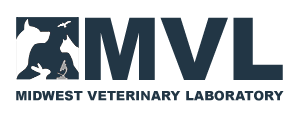Accurate results require proper sample handling and collection
- Ethylene diamine tetraacetic acid (EDTA) (lavender top tube) is the preferred anticoagulant for complete blood counts (CBC) and most hematology procedures where counting or sizing of cellular components, morphological hematology or blood typing is requested. Exceptions are birds and reptiles where lithium heparin is the preferred anticoagulant.
- For complete blood counts the correct ratio of blood to anticoagulant is important for accurate results. At MVL 2ml plastic EDTA tubes with hemogard caps are used. A minimum of 1ml of blood should be drawn into these tubes. Underfilling or overfilling of tubes may result in abnormal results, due to blood being excessively diluted with anticoagulant.
- Fasting samples are preferred but not essential for hematology procedures. Samples with marked lipemia will interfere with hemoglobin, MCH, MCHC, fibrinogen, and plasma protein determinations.
- When drawing blood with a syringe, do not force blood into tube through needle. The negative pressure in blood tubes will automatically vacuum the correct amount into the tube. Pierce the rubber stopper/cap with the needle and allow the vacuum to pull the syringe plunger or fill to capacity via vacutainer. Forcing blood into the tube through the needle may cause lysis and distortion of cells.
- After blood is drawn rotate tube 5-10 times to thoroughly mix blood with anticoagulant. Inspect tube and observe for clots. Do not submit EDTA tubes with clots.
- For coagulation studies a blue top sodium citrate tube is required for most procedures. Tubes should be at least half full. Avoid clots; any clots in tube will invalidate coagulation assays.
- Excessive heat or freezing will invalidate most hematology procedures. Blood should be refrigerated until courier picks up.
